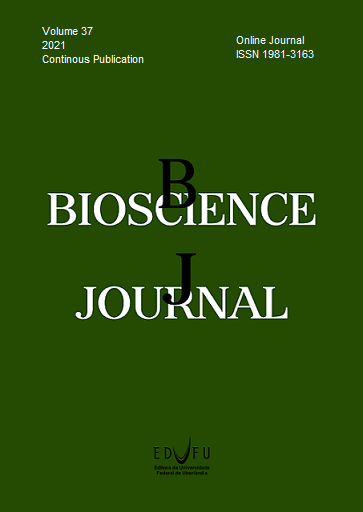Phytochemical, antibacterial and antioxidant screening of Artemisia santolinifolia various parts
DOI:
https://doi.org/10.14393/BJ-v37n0a2021-54206Keywords:
Artemisia santolinifolia, Antioxidant Potential, Antibacterial Activity, Phytochemicals.Abstract
The current study was carried out to explore the phytochemical, antioxidant potential and antibacterial activities of the crude methanolic extract of A. santolinifolia Turcz. Ex Besser. The antioxidant activity was carried out by using 1,1-diphenyl-2-picrylhydrazyl (DPPH) and 2,2’-azino-bis-3-ethylbenzthiazoline-6-sulphonic acid (ABTS) assay, while methanolic extract displayed the highest scavenging activity (DPPH) was 61.31µg/ml on Artemisia santolinifolia root and the lowest (51.05µg/ml) was record for their leaves. Similarly, in (ABTS) the highest activity (89.16µg/ml) was recorded for roots of A. santolinifolia followed by leaves (68.14µg/ml). In low inhibitory concentration assay, the crude methanolic extracts showed significant inhibition against all tested microbes on different concentrations like 25 µg/ml, 50 µg/ml, and 100 µg/ml. The leaves extract of A. santolinifolia AsL showed MIC of 12.5µg/ml for B. subtilis, a gram-positive bacterium, 50µg/ml for gram positive bacteria S. aureus and 37.5 µg/ml for gram negative bacteria P. aeruginosa that is almost equal to the response of standard ciprofloxacin. Our current study revealed that Artemisia santolinifolia root (AsR) exhibited a significant antioxidant potential while AsL showed good antibacterial effect which is suggested to be used for treatment and management of different infectious diseases.
References
Ahameethunisa, A.R. and Hopper, W. Antibacterial activity of Artemisia nilagirica leaf extracts against clinical and phytopathogenic bacteria. BMC Complementary Medicine and Therapies. 2010, 10, 6. https://doi.org/10.1186/1472-6882-10-6
Ahmad, A., Shinwari, Z.K., Hussain, J. and Ahmad, I. Insecticidal activities and phytochemical screening of crude extracts and derived fractions from three medicinal plants Nepeta Leavigata, Nepeta Akurramensis and Rhynchosia Reniformis. Pakistan Journal of Botany. 2016, 48, 2485-2487.
Ahmad, B., et al. Antimicrobial, Phytotoxic, Haemagglutination, insecticidal and antioxidant activities of the fruits of Sarcococca saligna (D. Don) Muel. Pakistan Journal of Botany. 2015, 47, 313-319.
Balakrishnan, B. and Ayyavoo, J. Evaluation of antioxidant activity of Clitoria ternatea and Alternanthera sessilis plant extracts using model system for yeast cells. African Journal of Basic & Applied Sciences. 2013, 5(3), 134-138.
Doss, A. Preliminary phytochemical screening of some Indian medicinal plants. Ancient science of life. 2009, 29, 1-12.
Islam, et al. Qualitative and Quantitative Analysis of Phytochemicals in Some Medicinal Plants in Bangladesh. Journal of Chemical, Biological and Physical Sciences. 2016, 6, 530.
Kamal, M., et al. Anti-rheumatic potential of Pakistani medicinal plants: a review. Pakistan Journal of Botany. 2016, 48, 399-413.
Kotan, R., et al. Antibacterial activity of the essential oil and extracts of Satureja hortensis against plant pathogenic bacteria and their potential use as seed disinfectants. Scientia Horticulturae. 2013, 153, 34-41. https://doi.org/10.1016/j.scienta.2013.01.027
Krishnaveni, T., Valliappan, R., Selvaraju, R. and Prasad, P.N. Preliminary phytochemical, physicochemical and antimicrobial studies of Loranthus elasticus of Loranthaceae family. Journal of Pharmacognosy and Phytochemistry. 2016, 5, 7.
Mir, M.A., Sawhney, S. and Jassal, M. Qualitative and quantitative analysis of phytochemicals of Taraxacum officinale. Wudpecker Journal of Pharmacy and Pharmocology. 2013, 2, 1-5.
Morales, G., Paredes, A., Sierra, P. and Loyola, L.A. Antioxidant activity of 50% aqueous-ethanol extract from Acantholippia deserticola. Biological research. 2008, 41, 151-155. http://dx.doi.org/10.4067/S0716-97602008000200004
Narayanaswamy, N. and Balakrishnan, K. Evaluation of some medicinal plants for their antioxidant properties. International Journal of PharmTech Research. 2011, 3(1), 381-385.
Oktay, M., Gülçin, İ. and Küfrevioğlu, Ö.İ. Determination of in vitro antioxidant activity of fennel (Foeniculum vulgare) seed extracts. LWT - Food Science and Technology. 2003, 36, 263-271. https://doi.org/10.1016/S0023-6438(02)00226-8
Petrosyan, M., Sahakyan, N.Z. and Trchounian, A. Chemical composition and antimicrobial potential of essential oil of Artemisia dracunculus l., cultivated at high altitude Armenian landscape. Basic and applied research in microbiology, bioenergetics, and biotechnology. 2018, 52, 116-121.
Prabhavathi, R., Prasad, M., and Jayaramu, M. Studies on qualitative and quantitative phytochemical analysis of Cissus quadrangularis. Advances in Applied Science Research. 2016, 7(4), 11-7.
Qasim, M., et al. Phytochemical potentials and medicinal uses of twenty-four selected medicinal plants from Swabi, Pakistan. Journal of Rural Development and Agriculture, 1(1), 49-58.
Rajurkar, N.S. and Hande, S. Estimation of phytochemical content and antioxidant activity of some selected traditional Indian medicinal plants. Indian Journal of Pharmaceutical Sciences. 2011, 73, 146. https://doi.org/10.4103/0250-474x.91574
Riaz, M. and Rahman, N.U. Biological activities of Rubus fruticosus L. Collected from Dir (L), Pakistan. Pakistan journal of Botany. 2015, 47, 127-131.
Salhi, N., et al. Antifungal Activity of Aqueous Extracts of Some Dominant Algerian Medicinal Plants. BioMed research international. 2017, 2017, 7526291. https://doi.org/10.1155/2017/7526291
Sharma, V., et al. In vitro antimicrobial activity and GCMS analysis of essential oil of Artemisia maritima (Linn.) from Lahaul & Spiti (Cold Desert) region of North-Indian higher altitude Himalayas. Journal of Medicinal Plants. 2014, 2(1), 45-52.
Shoaib, M., et al. Synthetic flavone derivatives. An antibacterial evaluation and structure-activity relationship study. Bulgarian Chemical Communications. 2016, 48, 414-421.
Silva, D., Abeysundara, G.O., and Aponso, M.M.W. Extraction methods, qualitative and quantitative techniques for screening of phytochemicals from plants. American Journal of Essential Oils and Natural Products. 2017, 5(2),29-32.
Silva-alves, K., et al. Estragole blocks neuronal excitability by direct inhibition of Na+ channels. Brazilian Journal of Medical and Biological Research. 2013, 46, 1056-1063. https://doi.org/10.1590/1414-431X20133191
Umamaheswari, S. and Sangeetha, K.S. Anti-Inflammatory Effect of Selected Dihydroxyflavones. Journal of clinical and diagnostic research. 2015, 9(50, FF05-FF07. https://doi.org/10.7860/JCDR/2015/12543.5928
Vaquero, M.R., Serravalle, L.T., De Nadra, M.M. and De Saad, A.S. Antioxidant capacity and antibacterial activity of phenolic compounds from argentinean herbs infusions. Food Control. 2010, 21, 779-785. https://doi.org/10.1016/j.foodcont.2009.10.017
Zhang, H., Wu, J. and Guo, X. Effects of antimicrobial and antioxidant activities of spice extracts on raw chicken meat quality. Food Science and Human Wellness. 2016, 5(1), 39-48. https://doi.org/10.1016/j.fshw.2015.11.003
Downloads
Published
Issue
Section
License
Copyright (c) 2021 Tabinda Nowsheen, Ali Hazrat, Sayed Wadood Ali Shah, Shabana Bibi, Afshan Begum, Muhammad Mukhtiar, Adam Khan

This work is licensed under a Creative Commons Attribution 4.0 International License.





